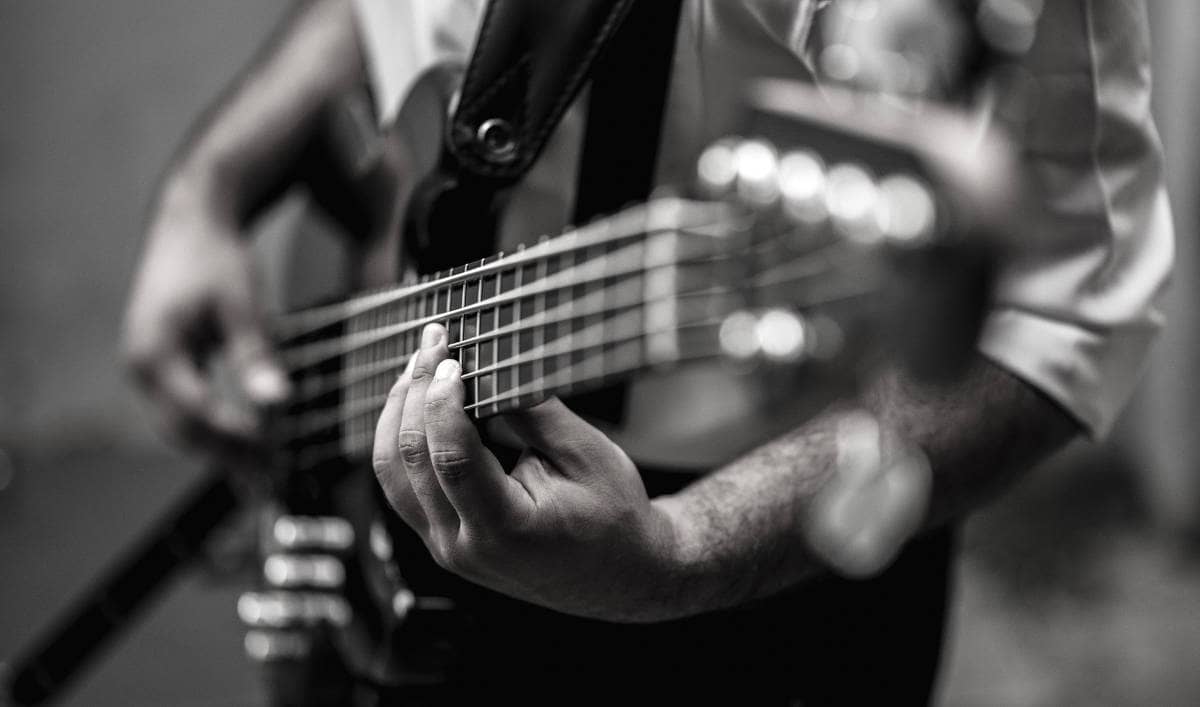As bassists we get used to writing lines that are deep and groovy, but how do you make melodic basslines?
For me, when I started playing the bass 14 years ago, all I wanted to was to play as melodically as possible. Despite me thinking that I made great basslines at the time, I did not. This was because my approach to playing a melody on the bass was unmethodical and all over the place.
Luckily, I have learned what I did wrong through the years; I even learned to do some things right.
Thus, I decided to write down my most helpful tips on how to create melodic bass lines. This way, you can take a more well-thought-out approach to learning melodic bass than I did, as well avoiding some common mistakes.
1. Listen to melodic bassists
There’s no better way for learning how to make melodic bass lines than listening to melodic bassists.
By just listening, you will find inspiration, tricks, and techniques that would be hard to learn on your own. Most importantly, you will see how one can play melodic bass lines in a band, while still filling in the low frequencies that bass is meant to fill.
I recommend listening to the following bassists to get an idea of what melodic bass can sound like The list is intended to give you a broad look at what melodic bass playing can sound like, not to showcase the most technical players.
| Bassist: | Band: | Reason to listen: |
| Paul McCartney | The Beatles | Articulated, methodical, creative |
| Geddy Lee | Rush | Groovy, complex, unique |
| Jaco Pastorius | Weather Report / Solo | Beautiful, versatile, use of harmonics |
| Les Claypool | Primus | Slapping, tapping, bass as a lead instrument |
| Flea | Red Hot Chili Peppers | Versatile, Funky, Adapts well to different styles |
| Matt Freeman | Rancid | Melodic punk, fast, complex without clashing with guitars |
| Billy Sheehan | Multiple | Technical, Virtuoso, solos |
I’ve had great success with taking some inspiration from bassists in genres I wouldn’t normally listen to. Melodies tend to tranced genres, so if you are looking to develop your melodic playing, it’s always a good idea to get inspiration from as many places as possible.
As an example, John Entwistle of The Who is a great melodic bassist who understands when to incorporate melodic elements. He also knows when to keep things simple.
“The Real Me”, is one of many The Who basslines where he plays a varied, complex, and melodic groove. Pay extra close attention to how the line works together with the vocals, guitar, and drums without ever being intrusive.
2. Learn scales
You don’t have to master music theory to play melodically on the 4-string. However, it will be difficult without some basic knowledge of scales.
In particular, you want to learn what notes make up the major and minor scale. The vast majority of songs are based on them, and they will be the foundation for most of your favorite basslines.
Here is an example of the C major and A minor scales, and how you can play them on the bass:
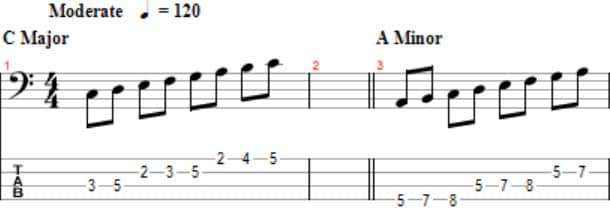
The intervals on your bass will always be the same regardless of what Major or Minor scale you are playing. This means that when you memorize the pattern that makes up a major scale, playing D Major, F Major, or any other major scale will be the same. The only difference is that the scale has to start on a different note.
When you know what scale is being played, you can start incorporating other notes from that scale into your bass lines. This makes it much easier to make lines that are harmonically sound.
3. Switch up your timing
As bassists, every single one of us has a unique style when it comes to constructing bass lines. This makes our playing distinct, but it can also stop us from noticing spots where we could have branched out.
Just like a great guitar solo, a melodic bass line should generally have some long and some fast notes in it.
Fast, arpeggiated 16th notes and long, sustained half notes are both viable ways to create a melodic line. However, in order to get good at playing the bass melodically, you want to experiment with both.
Exercise: Make a bass line that uses at least one 4th, an 8th, and a 16th note. Feel free to keep it simple, but do experiment with playing faster or slower in spots that feel unintuitive. I wrote the line below as an example of how this can be done:
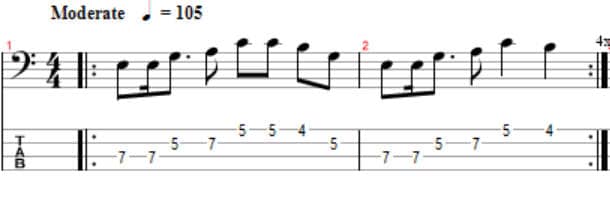
As you practice playing melodies, pay as much attention to what notes you are playing as to how you are playing them.
I’ve had hundreds of instances where I felt stuck writing a line and was looking for the right note. It’s embarrassing to admit how many times I discovered that I already had the right note, but not the right timing.
Thus, it is always best to experiment with different timings. Not only will this stop you from getting tunnel vision, but it will also lead you to make creative decisions you didn’t know you were capable of.
4. Avoid overplaying
How do you make a melodic bass line while maintaining the basic groove in a song? After all, the bass is supposed to fill the low-end in a band. Deviating from this job can quickly make a band sound messy or hollow.
This is why many bassists prefer to keep things simple. It’s always much better to play a straightforward groove than playing a complex one that doesn’t suit the song.
I made the mistake of not realizing this in my early days, and I’ve seen many bassists who want to be melodic make it too.
Unless you are playing a lead part, your focus should first and foremost be on providing groove. When writing melodic lines you should thus focus on providing groove first, and adding melodic elements when appropriate. Practice noticing spots where melodic bass lines are suitable, rather than trying to force them.
5. Start simple
When I first started learning how to play melodically on the bass, I was trying to do way too much. I always ended up with an over-the-top line that I had to tone down.
Nowadays, I’m having way better success with the opposite approach.
I start simple, and then I start building.
It’s fine to start with long sustained notes, a really basic groove, or even by plucking root notes. The simpler the line, the more creative space you have to take it wherever you want.
The example below features a groove at 5 stages. It starts by just playing root notes and evolves into a melodic bass line. Notice that by progressively adding small changes, it only takes a few steps to turn a basic bass line into a melodically intriguing one.
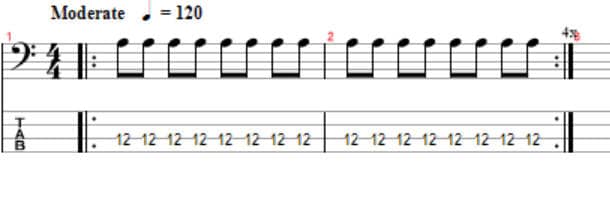
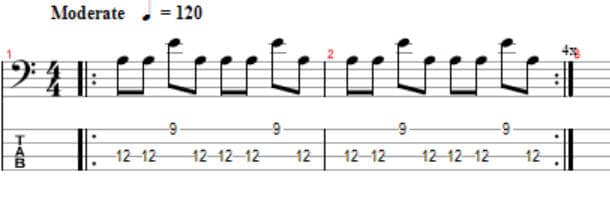
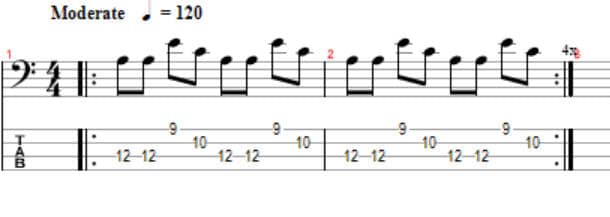
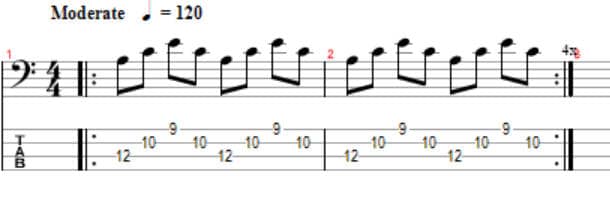
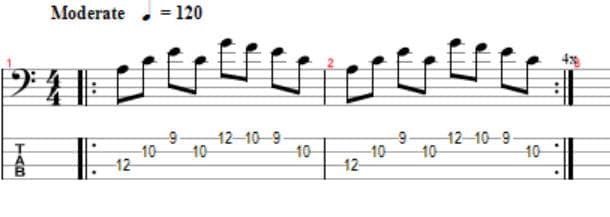
Notice how small, gradual changes can make a massive difference.
Writing this way achieves two things, your lines become unique, and they become sensible.
They become unique because you are constantly adding small details. While some bassists will make similar decisions, none will do exactly the same thing at every step of the process.
Your lines will be sensible because you are quality-checking it every step of the way. If you try changing something and it doesn’t sound good, you simply try something else. This leads you to make melodic lines that don’t go overboard with details or become too messy.
6. Play arpeggios
Arpeggios are chords that are played one note at a time, rather than strummed together.
Playing arpeggios is a simple, and often effective way to play melodies on the bass. As long as you know which chord is currently being played, you can also try incorporating arpeggios. It will work harmonically.
The majority of contemporary music mainly uses major and minor chords. This means that you only need to know 2 patterns in order to start incorporating arpeggios into your bass lines.
When starting on the root note of the chord, a major chord triad moves up 2 whole steps, and then one and a half steps. Similarly, minor chords triads first move up 1 and a half steps, and then 2 whole steps. This is all the knowledge you need to start playing arpeggios.
Exercise 2: Play the basslines below. It switches between a C minor and A# major chord that is played arpeggiated. Make sure that unplayed strings stay muted and don’t ring out. Memorize the finger pattern, as it will prepare you for playing arpeggios over the majority of common chords.
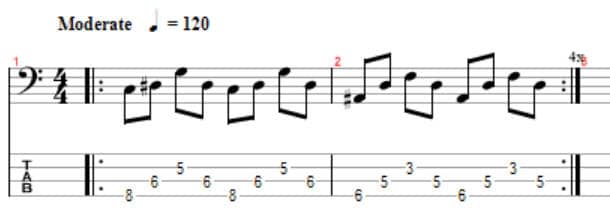
It’s also helpful to practice arpeggios both low and high on the neck. Higher up, arpeggios will be more prevalent in a mix and make the bass sound more like a lead instrument. Lower down, the melody will be less clear, but you will maintain the low-end and groove that the bass is supposed to provide.
7. Explore classical music
When you are looking to write better melodies, there is no better genre to study than classical.
It can be incredibly effective to learn from the piano, flute, or violin when playing the bass. The melodies can generally be played equally well on the 4-string and can be applied effectively in modern music.
A great place to start is to listen to your favorite classical pieces and mimic the melodies on the bass. Another great resource is Mark`s Bach2Bass, where he uploads bass transcriptions of Bach’s music, adapted for the bass guitar.
Given that the majority of classical composers lived hundreds of years ago, a lot of classical music is also in the public domain. This means that you can freely use a lot of it without having to worry about copyright infringement.
Of course, it’s best to use it as inspiration. However, it’s great to know that if you end up with a bass line that is eerily similar to a piece of classical music, it’s rarely an issue.
For an example of how well classical music can work on the bass, check out the video below. It`s a bass arrangement of Mozart`s Lacrimosa by the great Nate Navarro. The arrangement is on the more complex side, but it serves as a great example of how classical music can greatly enhance your melodic playing.
8. Steal from other instruments
Vocal lines, piano, and lead guitar parts are great sources of melodic inspiration for bassists.
Kurt Cobain of Nirvana based several of his guitar solos on his own vocal lines. He did this on both “Smells Like Teen Spirit” and “Come as You Are”, which are some of the band’s biggest hits. This made the guitar solos more memorable and cohesive with the overall song.
In a similar vein, a bassist can steal elements from other instruments and use these to create melodic bass lines. This also makes it easier to write melodic lines that make sense within the context of a song.
A bass line, guitar riff, and vocal line sound much more cohesive when they share some similarities while still being distinct parts. Generally, you will be on your way to writing some great music when you are able to achieve this.
9. Think and feel
Playing melodic bass requires you to both understand and feel the music.
A common mistake bassists make is to focus too much on one or the other. If you want to learn how to create melodic bass lines, it is particularly important you strike a balance between the two.
What is a groovy bass line without feeling? The thinking equivalent of the question is: What is a melodic bass line without harmonic knowledge? (Doesn’t sound quite as poetic, but it’s true.)
If you are a thinker, you are considering what scale or chord you are playing and what notes would make sense to add harmonically. You base your decisions on knowledge.
If you are a feeler, you might extend a note, accent, or move higher or lower in pitch because it simply felt right. If you are unable to put into words what made you make the decisions you made, you are a feeler. You base your decisions on intuition.
Exercise 3: Improvise a bass line. Notice whether you are thinking about the line or feeling it. Now improvise another line, and do the opposite.
It’s completely fine to gravitate towards being a feeler or thinker. I have met both feeling and thinking bassists who are better at the 4-string than I will ever become. What is important is to have some sense of both in order to play melodic bass lines well.
Conclusion
So can a bass guitar play melody? Absolutely. Bassists in a vast array of genres have become musical legends due to their melodic playstyle. Even more impressively, they all did so while still filling the role of bassist in a band.
The best way to get started playing melodic bass lines is to listen to lots of different music. Listen to melodic bassists from multiple genres, listen to all the instruments in classical music, and listen to the other instruments in your favorite songs.
This will give you a versatile source of inspiration, and give you lots of ideas to bass your melodic lines on.
Afterward, start working on your playing, slowly. Start with a basic line, then start implementing arpeggios and experimenting with different timings. This will all be easier if familiarize yourself with the major and minor scale as well.
Focus on both feeling and thinking about the music. As this becomes natural, focus on making your playing smooth and experiment with EQ to find a tone that suits your newly developed melodic style.
Most importantly, avoid going overboard with your playing. A bass guitar can only be melodic in a band when you are able to coexist with the other instruments.
If you want to learn more about how to improve your playing I suggest reading my 5 useful tips for jamming as a bassist. This will teach you how to make your melodic lines more groovy, and how to incorporate them when jamming with a band.

